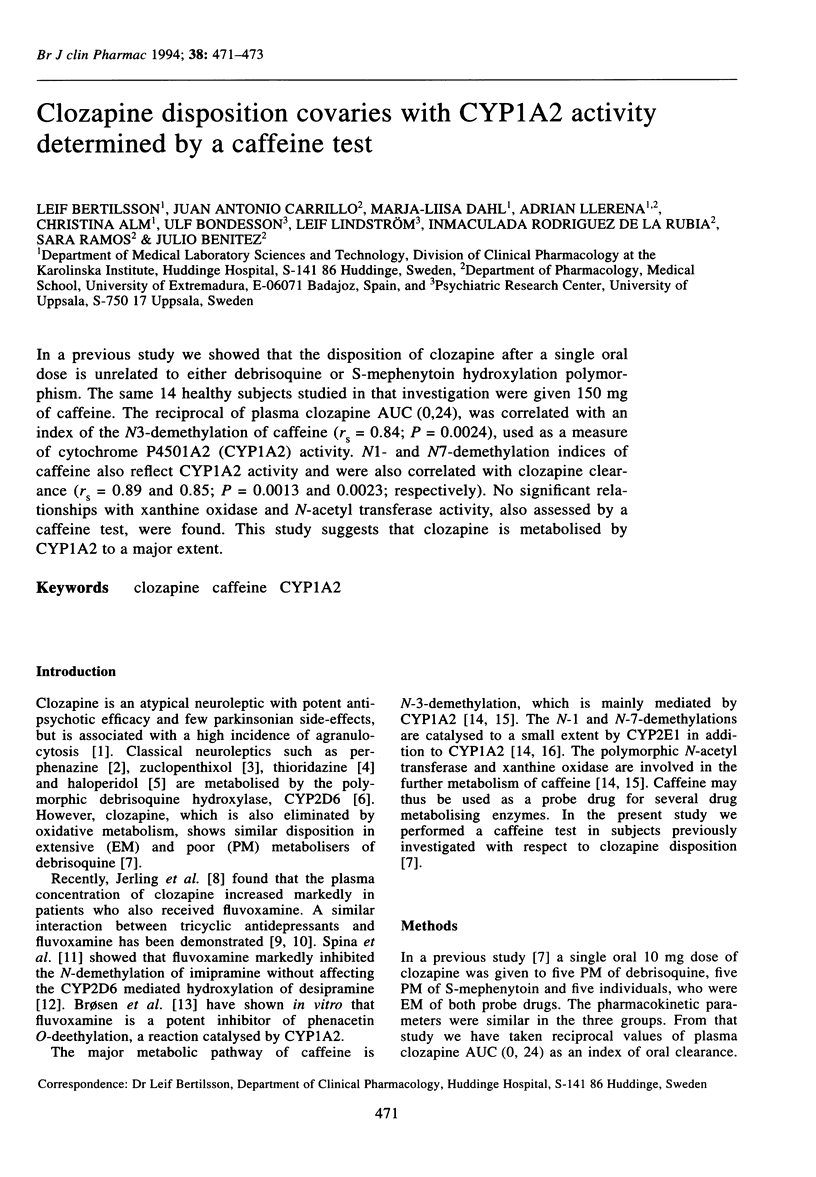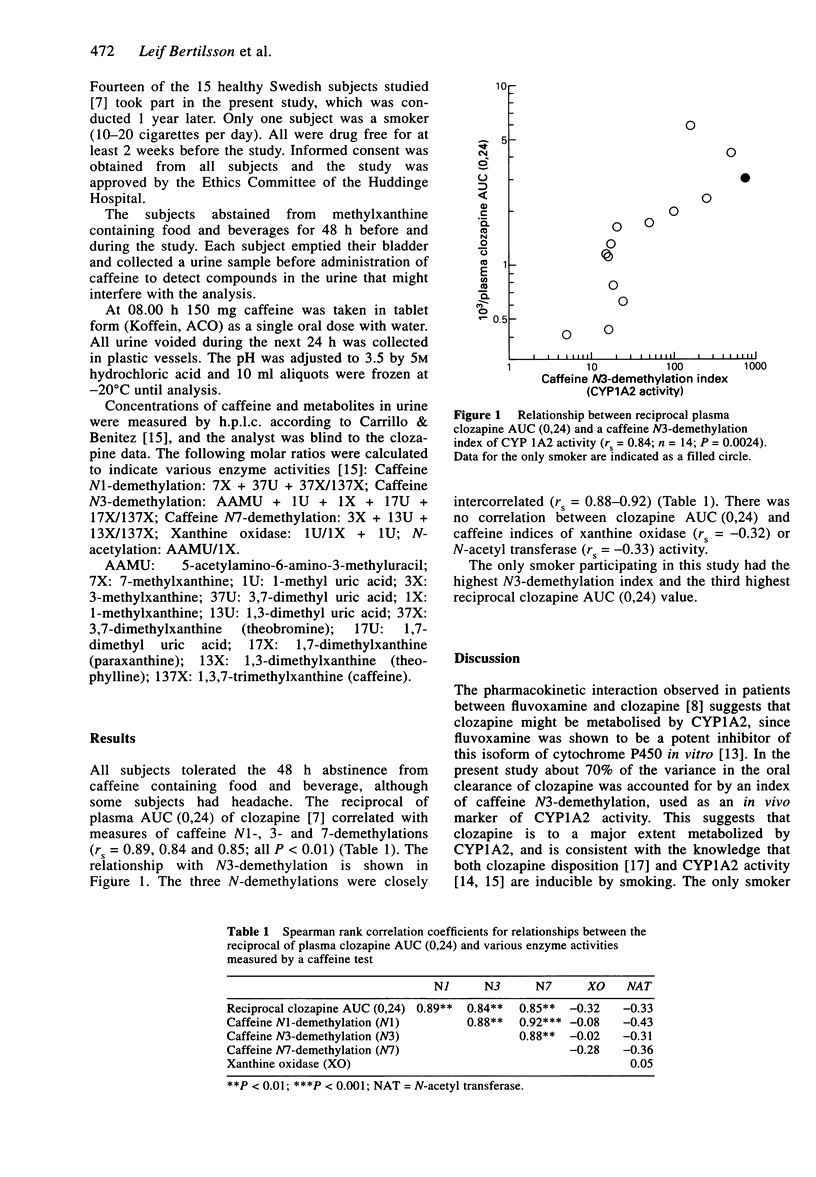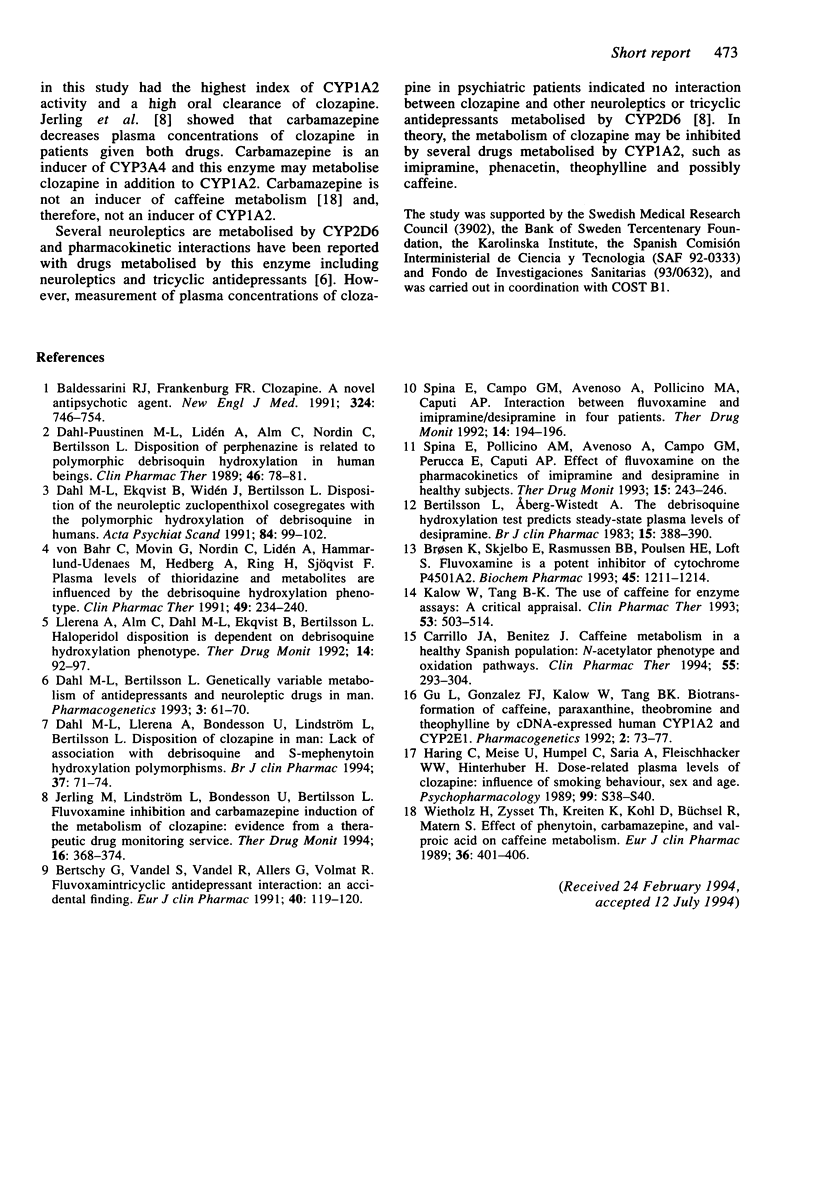Abstract
In a previous study we showed that the disposition of clozapine after a single oral dose is unrelated to either debrisoquine or S-mephenytoin hydroxylation polymorphism. The same 14 healthy subjects studied in that investigation were given 150 mg of caffeine. The reciprocal of plasma clozapine AUC (0,24), was correlated with an index of the N3-demethylation of caffeine (rs = 0.84; P = 0.0024), used as a measure of cytochrome P4501A2 (CYP1A2) activity. N1- and N7-demethylation indices of caffeine also reflect CYP1A2 activity and were also correlated with clozapine clearance (rs = 0.89 and 0.85; P = 0.0013 and 0.0023; respectively). No significant relationships with xanthine oxidase and N-acetyl transferase activity, also assessed by a caffeine test, were found. This study suggests that clozapine is metabolised by CYP1A2 to a major extent.
Full text
PDF


Selected References
These references are in PubMed. This may not be the complete list of references from this article.
- Baldessarini R. J., Frankenburg F. R. Clozapine. A novel antipsychotic agent. N Engl J Med. 1991 Mar 14;324(11):746–754. doi: 10.1056/NEJM199103143241107. [DOI] [PubMed] [Google Scholar]
- Bertilsson L., Aberg-Wistedt A. The debrisoquine hydroxylation test predicts steady-state plasma levels of desipramine. Br J Clin Pharmacol. 1983 Mar;15(3):388–390. doi: 10.1111/j.1365-2125.1983.tb01518.x. [DOI] [PMC free article] [PubMed] [Google Scholar]
- Bertschy G., Vandel S., Vandel B., Allers G., Volmat R. Fluvoxamine-tricyclic antidepressant interaction. An accidental finding. Eur J Clin Pharmacol. 1991;40(1):119–120. doi: 10.1007/BF00315151. [DOI] [PubMed] [Google Scholar]
- Brøsen K., Skjelbo E., Rasmussen B. B., Poulsen H. E., Loft S. Fluvoxamine is a potent inhibitor of cytochrome P4501A2. Biochem Pharmacol. 1993 Mar 24;45(6):1211–1214. doi: 10.1016/0006-2952(93)90272-x. [DOI] [PubMed] [Google Scholar]
- Carrillo J. A., Benítez J. Caffeine metabolism in a healthy Spanish population: N-acetylator phenotype and oxidation pathways. Clin Pharmacol Ther. 1994 Mar;55(3):293–304. doi: 10.1038/clpt.1994.30. [DOI] [PubMed] [Google Scholar]
- Dahl-Puustinen M. L., Lidén A., Alm C., Nordin C., Bertilsson L. Disposition of perphenazine is related to polymorphic debrisoquin hydroxylation in human beings. Clin Pharmacol Ther. 1989 Jul;46(1):78–81. doi: 10.1038/clpt.1989.109. [DOI] [PubMed] [Google Scholar]
- Dahl M. L., Bertilsson L. Genetically variable metabolism of antidepressants and neuroleptic drugs in man. Pharmacogenetics. 1993 Apr;3(2):61–70. doi: 10.1097/00008571-199304000-00001. [DOI] [PubMed] [Google Scholar]
- Dahl M. L., Ekqvist B., Widén J., Bertilsson L. Disposition of the neuroleptic zuclopenthixol cosegregates with the polymorphic hydroxylation of debrisoquine in humans. Acta Psychiatr Scand. 1991 Jul;84(1):99–102. doi: 10.1111/j.1600-0447.1991.tb01428.x. [DOI] [PubMed] [Google Scholar]
- Dahl M. L., Llerena A., Bondesson U., Lindström L., Bertilsson L. Disposition of clozapine in man: lack of association with debrisoquine and S-mephenytoin hydroxylation polymorphisms. Br J Clin Pharmacol. 1994 Jan;37(1):71–74. doi: 10.1111/j.1365-2125.1994.tb04242.x. [DOI] [PMC free article] [PubMed] [Google Scholar]
- Gu L., Gonzalez F. J., Kalow W., Tang B. K. Biotransformation of caffeine, paraxanthine, theobromine and theophylline by cDNA-expressed human CYP1A2 and CYP2E1. Pharmacogenetics. 1992 Apr;2(2):73–77. doi: 10.1097/00008571-199204000-00004. [DOI] [PubMed] [Google Scholar]
- Haring C., Meise U., Humpel C., Saria A., Fleischhacker W. W., Hinterhuber H. Dose-related plasma levels of clozapine: influence of smoking behaviour, sex and age. Psychopharmacology (Berl) 1989;99 (Suppl):S38–S40. doi: 10.1007/BF00442557. [DOI] [PubMed] [Google Scholar]
- Jerling M., Lindström L., Bondesson U., Bertilsson L. Fluvoxamine inhibition and carbamazepine induction of the metabolism of clozapine: evidence from a therapeutic drug monitoring service. Ther Drug Monit. 1994 Aug;16(4):368–374. doi: 10.1097/00007691-199408000-00006. [DOI] [PubMed] [Google Scholar]
- Kalow W., Tang B. K. The use of caffeine for enzyme assays: a critical appraisal. Clin Pharmacol Ther. 1993 May;53(5):503–514. doi: 10.1038/clpt.1993.63. [DOI] [PubMed] [Google Scholar]
- Llerena A., Alm C., Dahl M. L., Ekqvist B., Bertilsson L. Haloperidol disposition is dependent on debrisoquine hydroxylation phenotype. Ther Drug Monit. 1992 Apr;14(2):92–97. doi: 10.1097/00007691-199204000-00003. [DOI] [PubMed] [Google Scholar]
- Spina E., Campo G. M., Avenoso A., Pollicino M. A., Caputi A. P. Interaction between fluvoxamine and imipramine/desipramine in four patients. Ther Drug Monit. 1992 Jun;14(3):194–196. doi: 10.1097/00007691-199206000-00004. [DOI] [PubMed] [Google Scholar]
- Spina E., Pollicino A. M., Avenoso A., Campo G. M., Perucca E., Caputi A. P. Effect of fluvoxamine on the pharmacokinetics of imipramine and desipramine in healthy subjects. Ther Drug Monit. 1993 Jun;15(3):243–246. doi: 10.1097/00007691-199306000-00011. [DOI] [PubMed] [Google Scholar]
- Wietholtz H., Zysset T., Kreiten K., Kohl D., Büchsel R., Matern S. Effect of phenytoin, carbamazepine, and valproic acid on caffeine metabolism. Eur J Clin Pharmacol. 1989;36(4):401–406. doi: 10.1007/BF00558303. [DOI] [PubMed] [Google Scholar]
- von Bahr C., Movin G., Nordin C., Lidén A., Hammarlund-Udenaes M., Hedberg A., Ring H., Sjöqvist F. Plasma levels of thioridazine and metabolites are influenced by the debrisoquin hydroxylation phenotype. Clin Pharmacol Ther. 1991 Mar;49(3):234–240. doi: 10.1038/clpt.1991.22. [DOI] [PubMed] [Google Scholar]


